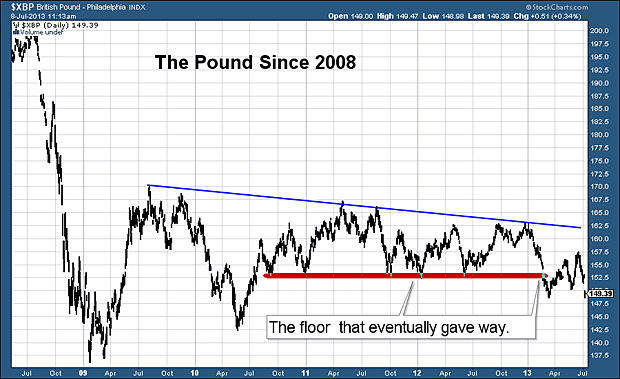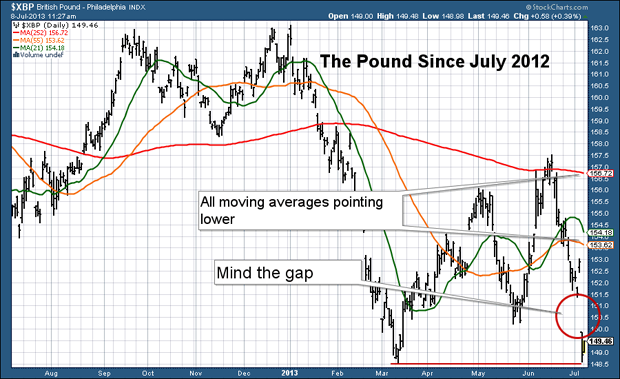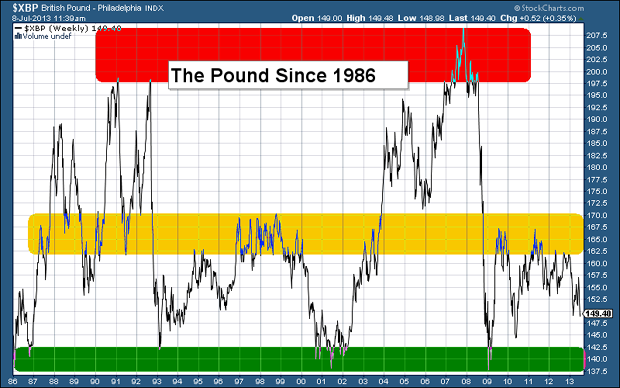Today I want to take a look at the pound in the light of new Bank of England governor Mark Carney’s first dramatic policy statement.
Last week, after his first Monetary Policy Committee meeting as governor, Carney basically told markets that he had no plans to raise interest rates next year or in 2015.
In other words, debtors will keep being rewarded, while savers can expect to be screwed.
The immediate effect was to send the FTSE 100 higher as markets cheered the prospect of looser money. The pound headed lower – looser monetary policy generally means a weaker currency.
So just how grim is the outlook for the pound under this new regime?
‘Very’ is the short answer. Here’s how low I think it will go…
The pound is being sucked into a powerful downward trend
In two days last week, the pound dropped from $1.53 to $1.48. Barely three weeks ago, on June 17, it stood at $1.57.
Trends are powerful things. They can go on and on, for longer than anyone expects. One of the secrets of successful investing is to identify them, get on board, and then stay on board.
The pound has been stuck in a range against the dollar for many years now. It has been building a base. Now a trend is forming off that base. And, with Carney’s support, it’s a trend that might last for a quite a while longer.
Have a look at the chart below
Source: StockCharts.com
In the five years since the wash-out of 2008, the pound has been making a sequence of lower highs. In other words, each time it drops in value then rallies, the rally peters out at a lower level than the previous one.
In 2009, it was $1.70, then $1.68. We got nowhere near those highs again amid all the insecurity that came with the 2010 election and the forming of the coalition government. In 2011 the highs continued to get lower: $1.67, then $1.66. At the end of 2012, we touched $1.63.
However, during this time, the pound at least enjoyed a solid ‘floor’ in the $1.52 to $1.53 area. Every time it hit this area, it would bounce – until 2013, that is, when on its seventh test of the level, the floor caved in.
On the chart (which I’ve reprinted below for convenience), you can see the gently narrowing range. The falling blue trend line marks the highs. The red band marks the floor that eventually gave way earlier this year.
Source: StockCharts.com
In the spring this year, the pound managed to claw its way back into that range. But it seems this was little more than a ‘gap’-filling exercise. A gap is what you get when the price of an asset opens a lot higher or lower than the previous closing price: you literally get a gap in the price chart.
When this happens, you tend to find that the market goes back and ‘fills’ the gap, before continuing upwards or downwards. I discussed this in relation to the pound earlier this year.
A long base like the one the pound has made often leads to a long trend – in this case, one that looks like it’s heading lower.
The pound looks set to rally – but it’ll soon be time to short it again
Let’s look now at a more recent chart of the pound over the last year. Here I have drawn three simple moving averages (ma). These show the average price of the pound over the previous 21 days (green line), 55 days (yellow line) and 252 days (red line). The point to note here is that the pound is sitting below all of them, and they are all pointed lower.
Source: StockCharts.com
In short, the trend is very much down.
However, before you all go out and bet the house shorting the pound, let me say this: I think we’re going to get a rally.
Not a big one – but the pound has found some support at $1.48. That’s the exact point where it made a low in March this year. Meanwhile, it has left a large gap, as circled below. As already mentioned, markets do not like gaps and they will often ‘back and fill’.
As well as the gap, another reason to expect a rally is that everyone is talking down the pound following Carney’s speech. When you see that, it often means the market is ‘oversold’ – ie it’s been shorted rather too enthusiastically – and you can expect a bit of a rebound.
So I think that we’ll get a rally to the $1.51 – $1.52 area. This will fill the gap and shake out the weak-handed shorts (ones who got into the trade late and may already be losing money).
But I fully expect the downtrend to resume rapidly after that. Carney hasn’t quite said it out loud, but the policy is clear. His big idea is to undermine the pound, thus bailing out debtors, home-owners and the government. Who cares about savers? They don’t carry much electoral weight.
There’s every likelihood this policy will be successful – I certainly see no reason to bet against it. The pound is the government’s (and the Bank of England’s) to undermine.
So at $1.51 – $1.52, I will look to go short again, with a stop just above around $1.545. My first target is $1.475. My next target is the low we hit at the last general election, of $1.42. Eventually, I suspect we’ll revisit the green band at the bottom of the following long-term chart, which shows the pound since 1986.
Source: StockCharts.com
It’s not a pretty picture, I think you’ll agree.
Just before I go, another reminder that you can still order one of the special first editions of my book, Life After The State, and get your name printed inside, before the trade edition comes out. Just click here and sign up. Many thanks!
Category: Market updates




